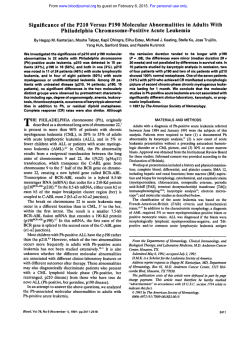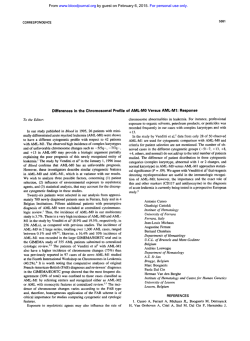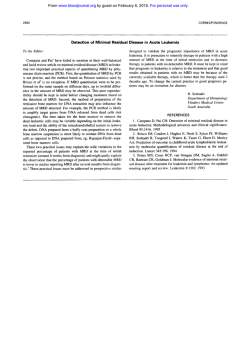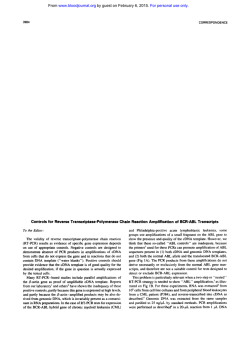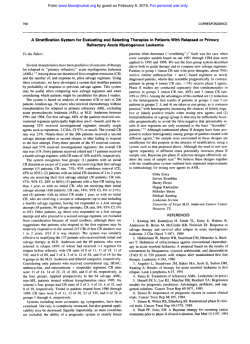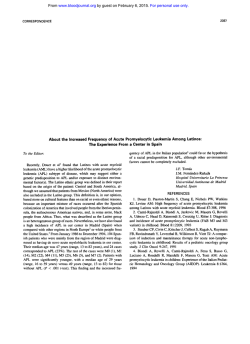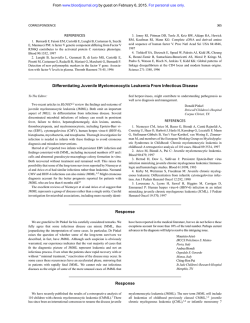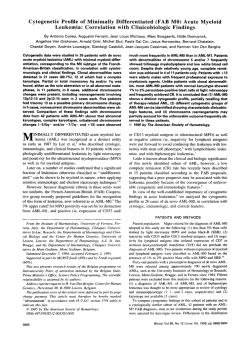
BCR/ABL P210 and P190 Cause Distinct Leukemia in
From www.bloodjournal.org by guest on February 6, 2015. For personal use only. BCR/ABL P210 and P190 Cause Distinct Leukemia in Transgenic Mice By Jan Willem Voncken, Vesa Kaartinen, Paul K. Pattengale, Wilfred T.V. Germeraad, John Groffen, and Nora Heisterkamp gin, with a relatively short period of latency. The observed DNA constructs encoding BCR/ABL P210 have been introdissimilarities are most likely due to intrinsically different duced into the mouse germ line using microinjectionof oneproperties of the P190 and P210 oncoproteins and may also cell fertilized eggs. Kinetics of BCR/ABL P210 expression in involve sequences that control transgene expression. The transgenic micewere very similarto those ofBCR/ABL P190 delayed progressionof BCR/ABL P210-associated diseasein constructs in transgenic mice. mRNA transcripts were dethe transgenic mice is consistent with the apparent indotectable early in embryonic development and alsoin hemalence ofhuman chronicmyeloid leukemia duringthe chronic topoietic tissue of adult animals. Expressionof BCR/ABL in phase. We conclude that, in transgenic models, comparable peripheral bloodprecededdevelopment of overtdisease. expression of SCR/ASL P210 and BCR/ABL P190 results in P210 founder and progeny transgenic animals, when becomclinically distinct conditions. ing ill, developedleukemiaof B, T-lymphoid, or myeloid 0 1995 by The American Society of Hematology. In contrast, P190origin after a relatively long latency period. transgenic mice exclusively developed leukemia of B-cell ori- recipients developed a CML-like myeloproliferative disease, RECIPROCAL TRANSLOCATION between chromolymphoblastic leukemia, or macrophage cell type tumors somes 9 and 22 results in the formation of the Philadelwithin 5 months.” Other investigators reported BCWABLphia (Ph) chromo~ome.”~ Although invariably associated mediated hematopoietic disease involving macrophage, with chronic myeloid leukemia (CML), the Ph-chromosome lymphoid, erythroid, and mast cell lineages. The incidence also occurs in a percentage of adult and childhood acute (69% to 100%) of the exact type of disease was strainlymphoblastic leukemias (ALL)4*5and in acute nonlymphodependent.” Myelomonocytic leukemias, granulocytic leucytic leukemia (ANLL). The [t(9;22)(q34;ql)] translocation kemias, and lymphocytic leukemiallymphomas were found fuses BCR to the ABL proto-oncogene. Activation of the Ab1 both with P210 and P190.23*24 It appears that the kinetics and tyrosine kinase in hybrid Bcr/Abl oncoproteins is considered the nature of the induced disease in this experimental setting, essential for the development of leukemia.6 The two major besides depending on the choice of internal promoter, depend forms of Bcr/Abl proteins, P190 and P210, differ only in the on culturing conditions, infection procedure, and genetic amount of Bcr amino acid residues included. P190 contains background of the grafted mi~e.’~.’~ It was further concluded only residues encoded by BCR gene exon l, whereas P210 that retroviral regulatory sequences may have influenced the contains residues encoded by BCR exons 1 to 13 or 14, outcome of the experiments. A major obstacle in retroviral depending on the exact location of the breakpoint on chromotechnology is targeting the infection to stem cells. This is some 22. P190 appears to be associated mainlywith Ph+ essential, because CML is thought to be a clonal disease ALL, whereas P210 is found both in Ph+ ALL and in originating in the hematopoietic stem cell.” CML.’” A different model system is created through the use of The 160-kD BCR gene product contains several distinct transgenic mice because the gene of interest will be present domains. The segment encoded by exon 1 harbors a serine/ in every cell. In previous studies, we have generated mice threonine kinase activity in vitro and is held responsible for transgenic for a BCWABL P190 construct under the tranactivating ABL in the chimeric BCWABL gene scriptional regulation of a mouse metallothionein (MT-l) BCR exons 3 through 10, which are present in BCWABL promoter; most transgenic founder animals and progenydied P210 but not in BCWABL P190, share sequence homology rapidly of an acute leukemia, which was clinically classified with a guanine nucleotide-exchange factor for human as A L L . ~ ~ - ~ O Initial attempts to generate a transgenic mouse CDC42, the DBL proto-onc~gene.’~”~ The C-terminal end model for human CML with a BCWABL P210 transgene of p16OBCr has GTPase-activating protein (GAP) activity toward the small GTP-binding proteins Racl/2 and CDC42 in Examination of bcr null-mutant mice recently Fromthe Department of Pathology Research and Laboratory connected ~160’“ GAP in vivo to regulation of superoxide Medicine, Divisions of Molecular Carcinogenesis and Haematopaproduction by the NADPH-oxidase system in myeloid and thology, Childrens Hospital of Los Angeles, Los Angeles, CA. B-lymphoid cells”. Submitted June 2, 1995; accepted August S, 1995. Involvement of the ~ 1 4 5in~cytoplasmic ~ ’ as well as nuSupported by Grant No. CA50248 from the Public Health Service clear processes has been suggested based on in vitro experito N.H. and by a Childrens Hospital Los Angeles Research Award ments.I8 In vivo, abl null-mutant mice are runted and die to J. W.V. within 2 weeks after birth. In addition, many show B- and TAddress reprint requests to Nora Heisterkamp, PhD, Department cell lymphopenia, the cause of which remains ~ n k n o w n . ’ ~ . ~of~Parhology Research and Laboratory Medicine, Division of Molecular Carcinogenesis, Childrens Hospital of Los Angeles, 4650 Sunset However, the exact function of Ab1 during development and Blvd, Los Angeles, CA 90027. cellular differentiation in mammals is still unclear. The publication costs of this article were defrayed in part by page To investigate the role of the chimeric BCWABL gene charge payment. This article must therefore be hereby marked in leukemia, BCWABL P210-encoding retroviral constructs “advertisement” in accordance with 18 U.S.C. section 1734 solely to have been introduced into mouse bone marrow and transindicate this fact. planted into lethally irradiated recipients. Different types of 0 1995 by The American Society of Hematology. hematopoietic disease were found. In one study, 43% of the 0006-4971/95/8612-0029$3.00/0 A Blood, Vol 86, No 12 (December 15). 1995: pp 4603-4611 4603 From www.bloodjournal.org by guest on February 6, 2015. For personal use only. 4604 VONCKEN ET AL AMT-BCR/ABL P190 Transgenic SMT-BCWABL P190 animals have been described in detail elsewhere.’x~’”Mice transgenic for the MT-BCWAHL P210 constructs were generated as described.’x Founder animals were the offspring of matings between C57BLICBA F, animals. Transgenic progeny was the result of matings between transgenics and CS7BLxCBA F, mice. Progeny are identified by eight-digit numbers; the first four digits are those of the founder of that specific line, Histology. Pathologic analysis was performed, as described previously,” on autopsy material obtained at killing from mice that were generally terminally ill. Routine histology examinations included bone marrow, lymph nodes, liver, kidney, spleen, and thymus. Tissue sections were fixed in 10% formalin, 90% BS. All MT-BCW ABL P21 0 males displayed fertility problems; severely reduced testis size and aspermia were frequently encountered. For this reason. only a limited amount of offspring was obtained from MT-BCWABL founders. The SMT-BCWABL P210 and P190 animals apparently had normal fertility. Periodic monitoring of peripherul blood for signs .f‘ diseuse. White blood cell (WBC) counts and BCWABL expression assays were performed regularly on peripheral blood from transgenic and control mice. Briefly, approximately 70 yL of blood was obtained via retro-orbital sinus bleeding. WBC counts were performed manually, as were differential WBC counts. Peripheral blood films were stained with Wright-Giemsa and evaluated histologically. Evidence of myeloid involvement (differential counts) in the period that preceded the development of overt leukemia in BCWABL P210 transgenic animals was not found. Fifty microliters of heparinized blood was used for RNA isolation. Redblood cells were lysed in two successive treatments with 20 vol of 0.144 mol/L NH,CI and 5 volof 0.01 mol/L NH4HC03interchanged with washes in normal phosphate-buffered saline (PBS). WBCs were pelleted and lysed in SO0 yL of solution D; RNA was isolated essentially as described.” The RNA pellet was suspended in 40 yL dH,Oand reverse transcriptase-polymerase chain reactions (RT-PCR) were performed on 8 yL, essentially as described: using combinations of ALL-E and ALL-F or CML-A and CML-H oligo-nucleotides as amplimers and ALL-G or CML-B as hybridization probe, respectively’5; in every experiment, RNA from the human CML cell line K562 or from a P190-expressing mouse lymphoma was used as a positive methodologic control. In previous experiments, the level of sensitivity of the RT-PCR method for BCWABL P190 expression was established at 1 in 100,000 nucleated cells.‘” To verify that a certain RNA sample was suitable for RT-PCR reactions, it was tested for mouse actin expression using a 3’ amplimer (S’-CGGTTGGCCTT AG GGTTCAGGG3 ’ ) and a S’ amplimer (S’-GTGGGCCGCTC-TAGGCACCAA-3‘).’” In some experiments, an oligonucleotide probe (S’-ACTCCTATGTGGG-TG ACGAGG-3’) contained within the amplified region was used for hybridization probe. Composition of hematopoietic tumors und peripheral blood .sumples. Composition of hematopoietic tissues was determined by double-color flowcytometry on a FACScan (Becton Dickinson, Lincoln Park, NJ). Briefly, tissues were disaggregated and washed twice in cold PBS. Approximately 1 X 10‘ WBCs were stained with phycoerythrin (PE)-and/or fluorescein isothiocyanate (F1TC)-conjugated antibodies for 20 to 30 minutes in 50 to 100 yL RPM1 containing 3% fetal bovine serum and 0.1% sodium azide on ice in the dark. Cells were then washed in PBS, fixed in I % paraformaldehyde, and analyzed. Monoclonal antibodies used include anti-CD45R (RA36B2). anti-CD45 (30F1 I . l ) , antiLCD36 (145-2C1 l), anti-Thy1.2 (532.1). anti-GR-l (RB6-8CS; PharMingen, San Diego, CA), and antiC D l l b (M1/70.15; Caltag, San Francisco, CA). Southern analysis. Tissue DNAs were isolated as described.’x DNAs digested with EcoRI, HindIII, and BamHl were run on 0.7% gels, blotted to nitrocellulose, and hybridized to a 1.2-kb Msp I/ I MT-BCRIABL P210 A MT-BCR/ABL P210 Fig 1. Schematicrepresentation of human BCR/ABL transgenic constructs. Expression of the MT-BCR/ABL P210 transgene (middle line) is regulated by the completemouse metallothionein (MT-1) gene promoter, whereas the SMT-BCR/ABL P210 transgena (lower line) is controlledby a part of the MT promoter (seethe Materials and Methods). Promoter sequencesin the SMT-BCR/ABL P190 construct (upper line) are identicalto those of thesMT-BCR/ABL P210 construct (lower line). As described in the Materials and Methods, different combinations of BCR and ABL genomic and cDNA sequenceswere used to generatetheseconstructs.Thinlinesindicate intron sequences. Hatched boxes represent BCR gene exons. Black boxesr e p resent ABLgeneexons. The smallblackboxes 5’ to BCR exon 1 represent murine MT-1 promoter sequences. controlled by the human BCR promoter failed because of deleterious effects of the construct on embryogenesis; no live offspring were obtained.3’We present here the generation of mouse lines transgenic for MT-BCWABL P210 constructs and describe the development of hematopoietic neoplasia caused by the P210 transgenes. MATERIALS AND METHODS Transgenes and mice. The MT promoter in the bMT-BCWABL P210 construct (Fig 1) lacks the glucocorticoid-responsive element and is identical to that used before to generate GMT-BCRLABL P190 transgenic animals.**The GMT-BCWABL P210 construct was generated by ligating a 5’ Clu I-Sal I fragment containing the truncated MT-I promoter (a 200-bp Sst I-Bgl I1 fragment’*) and BCR gene exon 1 until the Sal I site to a large Sal I-Cia I fragment encompassing the remainder of BCWABL. The latter fragment was derived from the previously described cosmid cl(8)der, a BCWABL DNA construct containing the human BCR gene promoter.” The Sal ICia I fragments were ligated into vector pHEP and packaged in vitro. The 32.5-kb cosmid insert was separated from the vector by pulsed-field gel electrophoresis. In this construct, the entire BCR coding region up to Mbcr exon 3 (BCR exon 14) and ABL exons 2 through 8 are contained within one large cDNA fragment. The rest of ABL includes introns and is a genomic sequence. The MT-BCW ABL P210 was constructed from three segments: (1) the complete murine MT-1 promoter fused to BCR exon 1 plus a segment of 3’ intron; (2) the intron immediately preceding BCR gene exon 2 and additional BCR gene exons up to and including Mbcr exon 2 and Mbcr exon 3 with flanking introns; and ( 3 ) ABL exon 2 with 5’ and 3’ introns and ABL exons 3 through I 1 as cDNA. From www.bloodjournal.org by guest on February 6, 2015. For personal use only. BCRIABL P210 TRANSGENIC MICE EcoRI JH, a 0.7-kb Pst I T-cell receptor-P (TCR-P), or a 2.8-kb BamHI Ck fragment respectively. Posthybridization washings were at 0.1 X SSC at 65°C. RNA isolation and expression in other tissues. RNAswereisolated as described34 usingguanidine-isothiocyanate. To test for early expression,timedmatingsbetween transgenic males and nontransgenic C57BlxCBAF1 females were setup and embryos isolated between days 13 and 15 of gestation. Three fetuses were pooledand homogenized immediately in solution D and stored at -80°C. Bone marrow, spleen, or tumor RNA was isolated after homogenizing part ofthetissue in slnD. One to three micrograms of total RNA was used per RT-PCR reaction. RT-PCR products were separated on 1% agarose gels, blotted to Nytran (Schleicherand Schuell, Keene, NH) and hybridized as indicated above. Immunoblotting. Tissueswereminced and homogenized in a Potterhomogenizer in 2Xsodiumdodecylsulfate (SDS) sample buffer and analyzed by Western blotting, as described.” The chimeric Bcr/Abl P190 and P210 oncoproteins were detected with the mouse monoclonal antibody Ab-3 (anti-c-Abl; Oncogene Science, Inc, Uniondale, NY). RESULTS Transgenes and transgenicanimals. To circumvent the problem of embryonic lethality observed with the human BCR pr~rnoter,~’ the mouse metallothionein-l promoter was chosen as an alternative regulatory sequence for BCWABL P210 transgenes. Analysis of a mouse model for human ALL in which this MT promoter was used to control P190 expression (the GMT-BCWABL P190 c o n s t r u ~ t ~ *Fig . ~1) ~; showed that transgenic animals developed pre-B-cell leukemia without prior exposure to heavy metals. BCWABL mRNA could be detected, by RT-PCR, as early as the 1 cell stage embryo and was found in all tissues examined at later stages.30This low level of transgene expression is apparently enough to predispose for cancer development. Subsequently, two BCWABL P210 DNA constructs were made (Fig l), both controlled by the murine MT-1 promoter. They differ in the length of the MT promoter segment included and in their intrordexon structure; the GMT-BCWABL P210 and GMT-BCWABL P190 constructs share identical MT promoter sequences (Fig 1).In transfected mouse NIH-3T3 cells, expression of both BCWABL P210 constructs resulted in the production of 210-kD proteins, which were active in autophosphorylation assays in vitro (data not shown). Transgenic founder and progeny animals were generated with both BCWABL P210 constructs (Table 1) and hematologic tumors were obtained. Animals containing a double GMT-BCWABL P210 transgene were also generated by breeding (ie, P210/P210). However, the transgene copy number had no influence on the kinetics and/or type of disease that developed (data not shown). Disease. Unlike mice transgenic for BCWABL P190, which developed pre-B-cell acute lymphoblastic leukemia, BCWABL P210 animals developed B- as well as T-cell leukemias with approximately the same frequency; no difference was found in type of disease between the two BCW ABL P210 constructs (Table 1). Tumor phenotype was confirmed by flow cytometric analysis (Fig 2) and Ig heavy and light chain and TCR-0 rearrangement (data not shown). The incidence of hematologic disease inGMT-BCWABL P210 mice was 58% and in MT-BCWABL P210 was 53%; in 4605 comparison, GMT-BCWABL P190 had a disease incidence of nearly 100% (Fig 3; see also Groffen et a13’). The experimental end point was arbitrarily chosen at 44 weeks; some €910-transgenic animals died ofBCWABL related disease after more than 1 year. In contrast to studies by others that reported the development of T-cell neoplasias upon injection of either BCWABL P190 or P210 retroviral vectors directly into the thymus,39 we have found no evidence that T-lymphoid cells are targets for BCWABL P190. Subsequent to the first reported study,28 among 14 newly generated founders andmorethan 200 transgenic offspring, none has shownany leukemia other than of the B-lineage. Neoplasias inBCWABL P210 animals were of both Band T-cell type and, less frequently, of myeloid origin. Blymphoid leukemias or lymphomas were invariably accompanied by splenomegaly and involvement of lymph nodes, but never involvement of the thymus. The majority of T-cell lymphoid leukemias involved the thymus, frequently lymph nodes and spleen; WBC counts were often extremely high. Mature lymphocytic leukemia (B or T) was further characterized by absence of mitotic figures in the peripheral blood. In both B-and T-lymphoid tumors, a coexisting but separate and presumably non-neoplastic prominent hematopoiesis (erythropoiesis and megakaryocytosis) was frequently observed in the spleen (data not shown). Because clonality (Ig heavy or light chain and/or TCR rearrangements) and/or Bcr/ Ab1 protein levels of isolated megakaryocyte populations were not evaluated, we cannot exclude the possibility that these phenomena related to direct oncogenic action of BCW ABL. Macrophage tumors were not found in either BCW ABL P190 or BCWABL P210 animals; primary granulocytic disease was not very prevalent. All leukemias were rapid in onset; no evidence for chronic disease was found in the peripheral blood. In a few cases, the myeloid compartment was involved at terminal stages of disease. Circulating mature neutrophil counts were increased in 1 case (1994/2663), and a relatively high percentage of cells in the bone marrow compartment of another terminally sick animal (1994/2685) stained positive for both B220 and GR-l (Fig 2B). Myeloblastic leukemia with a sarcomatous component in animal 2663 involved the red pulp in the spleen, lymph nodes, liver, and kidney (Table 1). In contrast to neoplastic lymphoblasts, the myeloblasts in animal 2663 showed a conspicuous rim of pinkish cytoplasm and appeared cohesive, particularly in the nonlymphoid red-pulp area of the s ~ l e e n . ~Because ~ , ~ ’ mouse 2685 showed a mild lymphoid proliferative disorder at an earlier stage, the myeloid involvement could have been be secondary to lymphoid tumorigenesis (ie, a deregulated cytokine production), as has been suggested before.22,2s Alternatively, BCWABL P210 expression could disturb differentiation or proliferation of relatively rare myeloid-lymphoid precursors. Taking these findings together, we conclude from our data that P190 and P210 cause clinically distinct disorders in a transgenic setting. Kinetics of transgene expression. To investigate whether differences in type of disease were associated with different levels of BCWABL expression, total protein was isolated From www.bloodjournal.org by guest on February 6, 2015. For personal use only. 4606 VONCKEN ET AL Table 1. Leukemogenesis in BCR/ABL P210-Transgenic Animals Tissue lnvolvernentt Age* Animal MT-BCR/ABL P210 1063 1063-1164 1102-1684 1102-1691 2160-2302 2179 6MT-BCR/ABL P210 1994-2619 1994-2661 1994-2663 1994-2683 1994-2685 1994-2710 1994-2720 1994-2725 1994-2744 1994-2748 1994-2762 1994-2777 1994-2779 1994-2781 1994-2784 (wkl BM SPL 11 13 17 15 20 15 + + 18 44 54 22 21 14 19 11 18 25 12 9 47 28 28 + + + + + + + + + + + + + + + + + + + + + + + + + + + + + + + + + + + + + - + - THY LN WBC* (xWirnLJ + 110 53 376 + 219 - lymphoma lymphocytic +B-lineage ND leukemia/lymphoma T-lineage + ND - + + + + Diagnosis§ B-lineage lymphoblastic leukemia Small B-lymphocytic leukemia Small T-lymphocytic leukemia/lymphoma Small T-lymphocytic leukemiallymphorna + + + - + + + - + + - + + + + + + + + + + + + + + + + ND 126 98 1 1 2 128 84 ND 19 29 56 32 196 ND T-lymphoblastic leukemia T-lymphocytic leukemia/lymphoma Myeloblastic leukemia//( B-lineage lymphoblastic lymphoma B-lymphocytic leukemia/lymphoma/l B-lymphoblastic lymphoma Small T-lymphoblastic leukemia/lymphoma T-lymphoblastic leukemia/lymphoma T-lineage leukemia/lymphoma T-lymphoblastic leukemia Small B-lymphocytic leukemia/lymphoma T-lymphocytic leukemia/lymphoma T-lymphoblastic lymphoma B-lineage lymphoblastic leukemia T-lymphoblastic lymphoma Abbreviation: ND, not done. * A g e at death; autopsies were performed on terminally ill animals or animals were followed up until they died. t Tissue involvement was established by gross pathologic and histologic examination. WBC count was either determined at or a few days before death. § Phenotype of lymphoid tumors was assessed by flow cytometry and lg and TCR gene rearrangement (see the Materials and Methods). 11 These animals displayed granulocytic involvement in the peripheral blood at terminal stages ofdisease. 1Diagnosis of myeloblastic leukemia in animal 2663 was based on pattern, general morphology, and anatomic sites involved (see also the Results). * from different end-stage tumors. However, lymphomas of all three transgenic animal lines expressed comparably high levels of the chimeric Bcr/Abl oncoproteins (Fig 4). We examined transgene expression using RT-PCR early in development and in bone marrow. Both BCWABL P210 transgenes were expressed early in utero in nonhematopoietic tissues (testis and brain; data not shown) and in the bone marrow and spleen of different transgenic animal lines (Table 2) without prior exposure to zinc or cadmium. As was the case in the 6MT-BCWABL P190 animal model, the appearance ofBCWABL P210 expressing cells in the peripheral blood preceded the development of overt leukemia.”’ Transgene expression in three transgenic mouse lines (founders animals 1102, 1989, and 1994) was investigated in more detail. Transgene expression in the bone marrow of nonleukemic animals was low (on average, 50 to > l O O X lower than in K562; data not shown); there was no apparent correlation between relative transgene expression levels and the development of disease among the different lines. Not all transgenic animals within the lines developed detectable peripheral transgene expression (Table 2). Moreover, appearance of transgene expression in circulating blood cells did not necessarily precede immediate development of disease. Some animals for which transgene expression in circulating nucleated cells had been confirmed between 10 and 16 weeks of age remained disease free for a long period, with some remaining disease free past 16 months of age. These observations were valid for both BCWABL P210 constructs. In P190 animals, a close correlation exists between transgene expression and development of disease.29The difference between P190 and P210 transgenic lines is also reflected in the different mortality curves (Fig 3). The large differences in latency time among transgenic animals indicates that BCWABL P210 expression is not the sole cause of leukemia but rather predisposes for the cancer. In agreement with current concepts, additional (epilgenetic mutations, directly or indirectly resulting from BCWABL expression, most likely contribute to malignant tumor evolution. DISCUSSION Transgenic mouse models allow directcomparison oj P210- and PI90-associateddisease. In recent years, attempts to generate a reliable animal model for the study of CML have been thwarted by lack of reliability and reproducibilit~.~’ The outcome of bone marrowtransplantation experiments using retroviral BCWABL P210 constructs was shown to depend largely on infection conditions, the retroviral and internal regulatory sequences used, andalso on genetic background of the irradiated recipient mice; in essence, the out- From www.bloodjournal.org by guest on February 6, 2015. For personal use only. 4607 BCRIABL P210 TRANSGENIC MICE lo4 P198 10. 2762 I I lo2 """_ 10' loo loo 10' lo2 lo3 10. loo lo' lo2 lo3 10. Thylf 0 U U m t Gr-l Fig 2. Flow cytometric analysis of BCR/ABL-positive tumors. (A) An example of a pre-B-cell leukemiellymphoma of a SMT-SCR/ABL P190 mouse, a B-lymphocytic Ieukemiallymphoma of a GMT-BCR/ASL P210 mouse (2762). and a small T-lymphocytic leukemia of a SMT-BCR/ABL P210 animal (2720). (B) Two examples of granulocytic involvement in P210-relatedleukemia (see Results). Animal 2685 showed B-lymphocytic leukemia with cells staining double positivefor B220and GR-l; mouse 2663 showed acute myeloblasticleukemia. All flow cytometric analyses were performed on peripheral blood samples. Animal identification numbers are printed in the top right corner of the respective graphs and correspond to those in Table 1. struct were designed to resemble the genomic BCWABL gene come of the disease was thought to depend on which hematopoietic progenitor cell was targeted by retroviral v e ~ t o r s . ~ ~ structures, .~~ with the exception of the MT promoter, which Myeloproliferative disorders could be obtained by manipuwas used to circumvent embryonic lethality observed when the BCR promoter was used." With the exception of addilating these experimental conditions. In this fashion, BCW ABL P190 and P210 were shown to cause similar disease.24 tional BCR coding sequences in the BCWABL P210 conEvenwith v-abl, which, under natural conditions, exclustructs, the ABL and promoter sequences were identical in sively induces pre-B-cell leukemia in mice, myeloproliferathese transgenes. One additional difference should be noted: introns are positioned differently among the constructs. tive illness could be produced.2' However, both BCWABL P210 constructs gave a similar In BCWABL transgenic animals, every cell, including heclinical spectrum of disease, despite different positioning of matopoietic stem cells, will contain a BCWABL transgene. Although the MT promoter used here does not target intron sequences. transgene expression exclusively to hematopoietic cells, it The present study shows that BCWABL P190-and P210mediated leukemogenesis clearly differ, despite the similaridoes allow expression in these cell types. However, leukemogenesis in our BCWABL transgenic mice is independent ties in transgene design. An independent study using an MTof influences of retroviral sequences or other experimental BCWABL P210 transgenic construct supports the distinct factors, such as infection and bone marrow culture condioncogenicity of BCWABL P190 and However, in tions. Hence, a transgenic mouse model is expected to more this study, mice exclusively developed T-cell leukemias, accurately reflect the leukemogenic properties of BCWABL. which may be related to transgene design including lack of Influence of Bcr protein moiely and BCR gene promoter introns and integration effects in the single line studied. on leukemogenesis. The P210 constructs and P190 conThe longer latency time of P210-associated leukemogene- From www.bloodjournal.org by guest on February 6, 2015. For personal use only. VONCKEN ET AL 4608 100 Mortality (%l Table 2. Transgene Expression in Bone Marrow of Different BCR/ABL P210 Lines Animal of Line" 60 BCRlABL P210 40 20 0 0 4 20 8 18 12 24 28 32 38 40 44 48 Age (weeks) Fig 3. Mortality curve of BCR/ABL P190- versus BCR/ABL P210transgenic mice. The data shown are a compilation of data from different transgenic lines. Both GMT-BCR/ABL P210 and MT-BCR/ABL P210 groups included F, (founder; n = 10 of both P210 transgenes combined) and F, and F?progeny animals (An = 36). A comparable selection of animals (including F. [n = 141, F,, and Fz animals of both sexes) is represented in the GMT-BCR/ABL P190 graph (0n = 42). sis, independent of whether a B- or T-lineage or myeloid leukemia develops, would seemto indicate intrinsic variation in biochemical properties between the two distinct oncoproteins. It has been reported that P190 Bcr/Abl has a higher autophosphorylation activity than P210 in vitro, a property that correlated with its higher transforming ability in cultured fibroblast cell lines."" Such differences in tyrosine kinase activity might, for example, have a differential effect on the differentiation of certain hematopoietic lineages andmay help explain the altered disease-spectrum associated with P2 IO as compared with P190. The combined findings in our transgenic mice show that, as in human leukemia, the additional Bcr domains included 1 2 3 4 4 4 P210 P190 Fig 4. BcrlAbl expression in primary tumors of transgenic aniof kD is indicated mals. A high molecular weight protein marker200 at theleft Isquare). Lanes 1 and 2, P190 expression in lymphomas of two different GMT-BCR/ABL P190 animals; lane 3, p210 expression in a T-cell lymphoma in a fiMT-BCR/ABL P210 mouse of the 1994 line; lane 4, transgene expression in a B-cell lymphoma of an MT-BCR/ ABL P210 animal. 6MT-BCR/ABL P210 168 170 171 1989 1994 2039 2043 MT-BCR/ABL P210 1063 1102 1105 2148 2160 2179 TGt xpr Disease in Mouse Line: Founder or Offspring ND NO + ND + + - + NO ND + + + + ND NO + + + - + + + + Of animal line170, the founder(170) and at least two of his offspring were evaluated for transgene expression; founder and 2 offspring of the 1989 line were found positive for low transgene expression in bone marrow; of line 1994, at least 20 F1 and F2 animals have been monitored periodically fortransgene expression and development of disease (see the Materials and Methods). Founders and at least two offspring oflines 2039 and 2043 were evaluated for transgene expression in bone marrow; only the2043 line had detectable BCWABL P210 mRNA. Animal lines 1063,1102,2148,2160, and 2179 all showed equal levels of transgene expression in bothspleen and bone marrow on average somewhat higher than the bMT-P210 lines. Offspring of lines 1063 (n = l ) , 1102 (n = 8). and 2148 (n = 3) were evaluated for transgene expression and found to bepositive. Of line 1102, at least 7 offspring were monitored periodically for transgene expression and development of disease (see the Materials and Methods). Transgene integrity in the different transgenic lines was assessed by restriction endonuclease digestion and Southern analysis. Abbreviations: ND, not determined; NO, no offspring sired by this founder. Animal lines are represented by founder identificationnumbers. t Transgene expression in bone marrow was evaluated in at least one transgenic animal per line by RT-PCR. in the P2 IO oncoprotein modulate the outcome of the disease. However, the mechanisms that govern these distinct leukemic processes are ngt understood. As indicated above, the Bcr domains modify the tyrosine kinase activity of the Ab1 moiety6 and also F-actin binding activities of c-Abl." In addition, the Dbl-homology'3 and pleckstrin-homology dom a i n only ~ ~ ~present in P210 may allow protein-protein interactions with other cellular factors that cannot occur with P190. Apart from its structural role in the Bcr/Abl oncoprotein, there appears to be a second discrete mechanism through which BCR may contribute to leukemogenesis. We have recently shown that the effect of bcr gene ablation specifically affects hematopoietic cells in mice affected by BCW ABL in humans and mice." It seems reasonable to conclude from our data that a correlation exists between the cell type affected in Ph+ leukemia and Bcr function. The BCR promoter controls expression of both the remaining nonrearranged BCR allele and the BCWABL oncogene in human From www.bloodjournal.org by guest on February 6, 2015. For personal use only. ECRIAEL P210 TRANSGENIC MICE leukemia. It is very well possible that regulatory sequences that normally govern BCR expression have substantial influence in directing BCWABL-mediated leukemogenesis. The prominent myeloid development in BCWABL P210mediated human CML may be related to the presence of factors in myeloid lineages that regulate BCR expression through specific elements in the BCR promoter. These factors may be less prevalent in human T- and B-cell lineages and preferentially direct BCR-promoted malignant transformation in granulocytes. All experimentally derived BCWABL lymphoid tumors were generated with regulatory sequences other than the BCR promoter. To date, all animals models for human Ph+ leukemia, whether generated through or transgenic technologies (Heisterkamp et al?' Honda et ai? Hariharan et al?' and this study), develop predominantly lymphoid malignancy of the B and T type. Although hematologic tumors in Ph+ ALL are principally of the pre-B phenotype, B-lymphoid involvement occurs in about 25% of cases of human CML in blast crisis and T-cell involvement is rarely seen in humans. It is tempting to speculate that regulatory sequences within the BCR transcriptional unit are important for the type of disease found in humans and mice. This concept contrasts with the postulate that (intransplantation experiments using BCWABL-expressing, retrovirus-infected bone marrow) neither BCR sequences nor myeloid cell promoter elements are essential for myeloid leukemogenic tran~formation.~~ Similarly, in a comparable experimental setting, the mere introduction of an activated ab1 gene into a certain target cell was proposed to control the selection of particular hematopoietic cell types andnot the BCR sequences that distinguish BCWABL P190 and BCWABL P210.24The findings presented here do not support these conclusions. Ph+ myeloidleukemia in human and mouse.BCWABL expression in human chronic myeloid leukemia results in myeloid expansion, which may increase the chance for additional mutagenic events, that ultimately accompany malignant transition to fatal blast crisis. We found evidence of myeloid disease at terminal stages of several BCWABL P210-transgenic animals, although the frequency was relatively low. Because no obvious evidence was found for the development of myeloid proliferative disorders secondary to other primary malignancies, we assume thatthe observed myeloid involvement was neoplastic. The mixed lymphoidmyeloid leukemia, which was found in 1 case, seems to indicate that BCWABL P210 expression, in contrast to BCW ABL P190, can disturb differentiation or proliferation of relatively rare myeloid-lymphoid precursors in the mouse. Such rare stem cell origins in Ph+ leukemia are occasionally en~ o u n t e r e d ~ ' .also, ~ ~ ; switching within myeloid and pre-B lymphoid tumor lineages has been rep~rted,~'showing a close developmental link between these hematopoietic lineages. The absence of a chronic phase and the low frequency of myeloid disease in the present study could be a direct result of the restricted size of the cell population subject to secondary mutational events in a small animal like the mouse. A similar scenario was suggested to explain the absence of 4609 retinoblastoma in animals heterozygous for the tumor-suppressor retinoblastoma susceptibility gene (Rb)-mutant anim a l ~ . Alternatively, ~' the mouse may be more prone to develop lymphoid neoplasias than spontaneous myeloid disorders." This finding, combined with the observation that BCWABL P210 targets cells of both myeloid and lymphoid origin in a transgenic setting, may explain the natural predilection for BCWABL-mediated lymphoid leukemia. In humans, about 50% of cases ofPh' ALL carry the BCWABL P190 translocation, with the other 50% carrying the P210 translocation. Consequently, the issue of whether Ph+ ALL is actually CML in blastic phase has been controversial for some time. However, clinical and molecular studies have recently established that Ph' ALL and acute-phase CML are indeed two distinct diseases.53All results of the present study support this concept. In transgenic mice, BCW ABL P210 clearly causes a distinct disease from BCWABL P190. This is caused by inherently distinct properties of P190 and P210, possibly including the intrinsically different kinase activities of the ABL moiety in the hybrid oncoproteins and/or cellular interactions of the Dbl and pleckstrin homology domains or as of yet to be identified domains in Bcr. In addition, regulatory sequences upstream from or within the BCR gene are likely to contribute to the occurrence of myeloid leukemia in humans and presumably in mice. These ideas will be the subject of future investigations in our laboratory. REFERENCES 1. Nowell PC, Hungerford DA: A minute chromosome in human chronic granulocytic leukemia. Science 132:1497, 1960 2. De Klein A, Geurtsvan Kessel A, Grosveld G, Bartram CR, Hagemeijer A, Bootsma D, Spurr NK, Heisterkamp N. Groffen J, Stephenson JR: A cellular oncogene is translocated to the Philadelphia chromosome in chronic myelocytic leukemia. Nature 300:765, 1982 3. Rowley JD: A new consistent chromosomalabnormalityin chronic myelogenous leukemia identifiedby quinacrine fluorescence and giemsa staining. Nature 243:290, 1973 4. Sandberg AA: Chromosomeinstabilitysyndromes,inThe Chromosomes in Human Cancer and Leukemia (ed 2). New York, NY, Elsevier, 1990, p 185 5. Priest JR, Robinson LL, McKenna RW, Lindquist LL, Warkentin PI, LeBien W, Woods WC, Kersey JH, Coccia PF, Nesbit ME Jr: Philadelphia chromosomepositive childhood acute lymphoblastic leukemia. Blood 56:15, 1980 6. Van Etten RA: The molecular pathogenesisof the Philadelphiapositive leukemias: Implications for diagnosis and therapy, in Freireich EJ,Kantarjian H (eds): Leukemia:AdvancesResearchand Treatment.Deventer,TheNetherlands,Kluwer Academic, 1993, p 295 7. Kurzrock R, Gutterman JU, Talpaz M The molecular genetics of Philadelphia chromosome-positive leukemias. N Engl J Med 319:990, 1988 8. Sawyers CL, Denny CT, Witte ON: Leukemia and the disruption of normal hematopoiesis. Cell 64:337, 1991 9. Heisterkamp N, Groffen J: Molecular insights into the Philadelphia translocation. Hematol Pathol 5:1, 1991 10. M m Y, Witte ON: TheBCR gene encodes a novel serine/ threonine kinase activity within a single exon. Cell 67:459, 1991 1 1 . McWhirter JR, WangJYJ:Activation of tyrosinasekinase From www.bloodjournal.org by guest on February 6, 2015. For personal use only. 4610 and microfilament-binding functions ofc-ab1by bcr sequences in bcrlabl fusion proteins. Mol Cell Biol 11:1553, 1991 12. Muller AJ,Young JC, Pendergast AM, Pondel M, Landau NR, Littman DR, Witte ON: BCR first exon sequences specifically activate theBCWABL tyrosine kinase oncogene of Philadelphia chromosome-positive human leukemias. Mol Cell Bid 1 1 : 1785, 1991 13. EvaA, Aaronson SA: Isolation of a new human oncogene from a diffuse B-cell lymphoma. Nature 316:273, 1985 14. Hart MJ, Eva A, Evans T, Aaronson SA, Cerione RA: Catalysis of guanine nucleotide exchange on the CDC42Hs protein by the dbl oncogene product. Nature 354:311, 1991 15. Diekmann D, Brill S, Garrett MD, Totty N, Hsuan J, Monfries C, Hall C, Lim L, Hall A: Bcr encodes a GTPase-activating protein for p21". Nature 351:400, 1991 16. Hart MJ, Maru Y, Leonard D, Witte ON, Evans T, Cerione A: A GDP dissociation inhibitor that serves as a GTPase inhibitor for the Ras-like protein CDC42. Science 258:812, 1992 17. Voncken JW, Van Schaick H, Kaartinen V, Landing B, Pattengale PK, Deemer K, Coates T, Dorseuil 0, Bokoch GM, Groffen J, Heisterkamp N: Increased neutrophil respiratory burst in bcr null mutants. Cell 80:719, 1995 18. Wang JYJ: Ab1 tyrosine kinase in signal transduction and cell-cycle regulation. Cum Opin Gen Dev 3:35, 1993 19. Tybulewicz VLJ, Crawford CE, Jackson PK, Bronson RT, Mulligan RC: Neonatal lethality and lymphopenia in mice with a homozygous disruption of the c-ab1 proto-oncogene. Cell 65: I 1 53, I991 20. Schwartzberg PL, Stall AM, Hardin JD, Bowdish KS,Humaran T, Boast S, Harbinson ML, Robertson EJ, Goff S P Mice homozygous for the abl'"' mutation show poor viability and depletion of selected B and T cell populations. Cell 65: 1 165, 1991 21. Daley GQ, Van Etten R, Baltimore D: Induction of chronic myelogenous leukemia in mice by the P210 BCWABL gene of the Philadelphia chromosome. Science 247:824, 1990 22. Elefanty AG, Hariharan IK, Cory S: BCWABL, the hall mark of chronic myelogenous leukemia in man, induces multiple hemopoietic neoplasms in mice. EMBO J 9:1069, 1990 23. Kelliher MA, McLaughlin J, Witte ON, Rosenberg N: Induction of a chronic myelogenous leukemia-like syndrome in mice with v-ab1 and BCWABL. Proc Natl Acad Sci USA 87:6649, 1990 24. Kelliher MA, Knott A, McLaughlin J, Witte ON, Rosenberg N: Differences in oncogenic potency but not target cell specificity distinguish the two forms of the BCWABL oncogene. Mol Cell Biol 11:4710, 1991 25. Elefanty AG, Cory S: Hematologic disease induced in BALBl c mice by a BCWABL retrovirus is influenced by the infection conditions. Mol Cell Biol 12:1755, 1992 26. Kelliher MA, Weckstein DJ, Knott AG, Wortis HH, Rosenberg N: ABL oncogenes directly stimulate two distinct target cells in bone marrow from S-fluorouracil-treatedmice. Oncogene 8:1249, 1993 27. Fialkow PJ, Jacobson RJ, Papayannopoulou T, Penfold GK, Jacobson RT, Hansen JA: Chronic myelocytic leukemia: Clonal origin in a stem cell common to the granulocyte, erythrocyte, platelet and monocytelmacrophage. Am J Med 63:125, 1977 28. Heisterkamp N, Jenster G, Ten Hoeve J, Zovich D, Pattengale PK, Groffen J: Acute leukaemia in bcrhbl transgenic mice. Nature 344:2S I , 1990 29. Voncken JW, Morris C, Pattengale P, Dennert G, Kikly C, Groffen J, Heisterkamp N: Clonal development and karyotype evolution during leukemogenesis ofBCWABL transgenic mice. Blood 79: 1029, 1992 30. Voncken JW, Griffiths S, Greaves MF, Pattengale PK, Hei- VONCKEN ET AL sterkamp N, Groffen J: Restricted oncogenicity of BCWABL P190 in transgenic mice. Cancer Res 52:4534, 1992 3 1. Heisterkamp N. Jenster G, Kioussis D, Pattengale PK, Groffen J: Human BCWABL gene has a lethal effect on embryogenesis. Transgenic Res1:45,1991 32. Stuart GW, Searle PF, Chen HY, Brinster RL, Palmiter RD: A 12 base-pair DNA motif that is repeated several times in metallothionein gene promoters confers metal regulation to a heterologous gene. Proc Natl Acad Sci USA 81:73 18, 1984 33. Pattengale PK, Stewart TA, Leder A, Sinn E, Muller W, Tepler I, Schmidt E, Leder P: Molecular analysis of transgenic mice carrying and expressing activated oncogenes. Am J Pathol 135:39. 1989 34. Chomczynski P, Sacchi N: Single-step method of RNA isolation by acid guanidinium thiocyanate-phenol-chloroform extraction. AnalBiochem 162:156, 1987 35. Kawasaki ES, Clark SS, Coyne MY, Smith SD, Champlin R, Witte ON, McCormick FP: Diagnosis of chronic myeloid and acute lymphocytic leukemias by detection of leukemia specificmRNA 85:5698, sequences amplified in vitro. Proc NatlAcadSciUSA 1988 36. Alonso S, Minty A, Bourlet Y, Buckingham M: Comparison of three actin-coding sequences in the mouse; evolutionary relationships between the actin genes of warm-blooded vertebrates. J Mol Evol 23: 1 1, 1986 37. Harlow E, Lane D: Antibodies: A Laboratory Manual. Cold Spring Harbor, NY, Cold Spring Harbor Laboratory, 1988 38. Groffen J, Voncken JW, Kaartinen V, Moms C, Heisterkamp N: Ph'-positive leukemia: A transgenic mouse model. Leuk Lymphoma IO: l , 1993 (suppl 2) 39. Clark SS, Chen E, Fizzotti M, Witte ON, Malkovska V: BCW ABL andv-ab1 oncogenes induce distinct patterns of thymic lymphoma involving different lymphocyte subsets. J Virol 67:6033, 1993 40. Hanecak R, Pattengale PK, Fan H: Addition or substitution of simianvirus 40 enhancer sequences into the Moloney murine leukemia virus (M-MuLV) long terminal repeat yields infectuous M-MuLV with altered biological properties. J Virol 62:2427, 1988 41, Pattengale PK: Tumours ofthe lymphohaematopoietic system, in Turusov V, Mohr U (eds): Pathology of Tumours in Laboratory Animals. Lyon, France, International Agency for Research on Cancer (WHO), 1994, p 651 42. Daley GQ: Animal models of BCWABL-induced leukemias. Leuk Lymphoma 11:57, 1993 43. Honda H, Fujii T, Takato M, Mano H, Witte ON, Yazalu Y, Hirai H: Expression of p21OBCWABL by metallothionein promoter induced T-cell leukemia in transgenic mice. Blood 85:2853, 1995 44. Lug0 TG, Pendergast A-M, Muller AJ, Witte O N Tyrosine kinase activity and transformation potency of bcr-ab1 oncogene products. Science 247: 1079, 1990 45. Mayer BJ, Ren R, Clark KL, Baltimore D: A putative modular domain present in diverse signalling proteins. Cell 73:629, 1993 46. Gishizky ML, Johnson-White J, Witte ON:Efficient transplantation of BCWABL-induced chronic myelogenous leukemia like syndrome in mice. Proc Natl Acad Sci USA 90:3755, 1993 47. Hariharan IK, Hams AW, Crawford M,Abud H, Webb E, Cory S, Adams JM: A bcr-v-ab1 oncogene induces lymphomas in transgenic mice. Mol Cell Biol 9:2798, 1989 48. Akashi K, Taniguchi S, Nagafuji K, Harada M, Shibuya T, Hayashi S, Gondo H, Niho Y: B-lymphoidmyeloid stem cell origin in Ph-positive acute leukemia with myeloid markers. LeukRes 17:549, 1993 49. Akashi K, Mizuno S, Harada M, Kimura N, Kinjyo M, Shibuya T, Shimoda K, Takeshita M, Okamura S, Matsumoto I, Kikuchi From www.bloodjournal.org by guest on February 6, 2015. For personal use only. BCRIABL P210 TRANSGENICMICE M, Niho Y: T-lymphoidmyeloid bilineal crisis in chronic myelogenous leukemia. Exp Hematol21:743, 1993 50. Martin M, Strasser A, Baumgarth N. Cicuttini FM, Welch K, Salvaris E, Boyd AW: A novel cellular model (SPGM 1) of switching between pre-B cell and myelomonocytic lineages. J Immunol 150:4395, 1993 5 1. Jacks T, Fazeli A M , Schmitt EM, Bronson RT, Goodell MA, 461 1 Weinberg RA: Effects of an Rb mutation in the mouse. Nature 359:295, 1992 52. Frith CH, Wiley LD: Classification an incidence of hyperplastic and neoplastic hematopoietic lesions in mice. J Geront 36534, 1981 53. Berger R: Differences between blastic chronic myeloid leukemia and Ph-positive acute leukemia. Leuk Lymphoma 11 :235, 1993 From www.bloodjournal.org by guest on February 6, 2015. For personal use only. 1995 86: 4603-4611 BCR/ABL P210 and P190 cause distinct leukemia in transgenic mice JW Voncken, V Kaartinen, PK Pattengale, WT Germeraad, J Groffen and N Heisterkamp Updated information and services can be found at: http://www.bloodjournal.org/content/86/12/4603.full.html Articles on similar topics can be found in the following Blood collections Information about reproducing this article in parts or in its entirety may be found online at: http://www.bloodjournal.org/site/misc/rights.xhtml#repub_requests Information about ordering reprints may be found online at: http://www.bloodjournal.org/site/misc/rights.xhtml#reprints Information about subscriptions and ASH membership may be found online at: http://www.bloodjournal.org/site/subscriptions/index.xhtml Blood (print ISSN 0006-4971, online ISSN 1528-0020), is published weekly by the American Society of Hematology, 2021 L St, NW, Suite 900, Washington DC 20036. Copyright 2011 by The American Society of Hematology; all rights reserved.
© Copyright 2025
